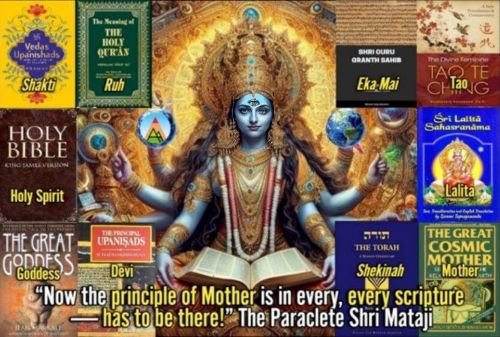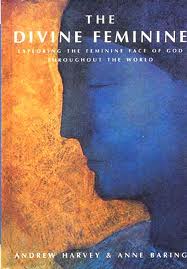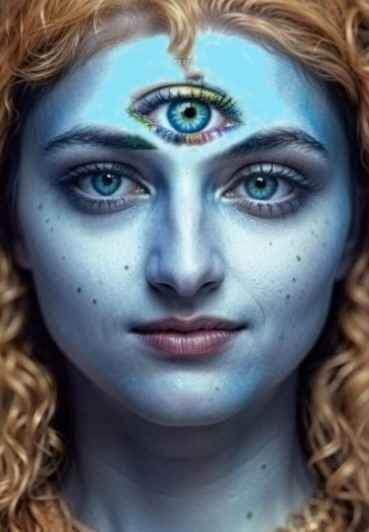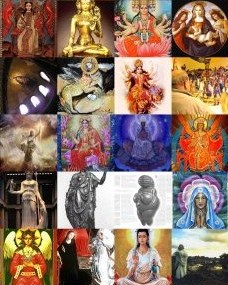The Divine Feminine in China

This article explores the Divine Feminine in Chinese culture, tracing her presence from ancient shamanic traditions to Taoist philosophy and mythology. Revered as the Primordial Mother, she appears as Hsi Wang Mu—the Queen Mother of the West—and Kuan Yin, the goddess of compassion. Through sacred landscapes, poetic wisdom, and the Taoist principle of Wu Wei, the feminine is honored as the source of life, balance, and intuitive knowing. Her resonance with global archetypes like Isis, Devi, and Mary affirms her universal role as the Protectress of Life and embodiment of mercy, love, and wisdom.

Mother of all Creation
Once, in China, as elsewhere, there was a Mother who was before heaven and earth came into being. Her image was woven into the age-old beliefs of the people and the shamanic tradition which later evolved into Taoism. In Chinese mythology, the mother goddess has many names and titles. One legend imagined her as an immense peach tree which grew in the Garden of Paradise in the Kun-Lun mountains of the West and was the support of the whole universe. The fruit of this marvellous and magical tree ripened only after three thousand years, bestowing immortality on whoever tasted it. The Garden of Paradise belonged to the Queen of the Immortals, the Royal Mother of the West, whose name was Hsi Wang Mu, goddess of eternal life. Other myths describe her as the Mother or Grandmother, the primordial Heavenly Being, the cosmic womb of all life, the gateway of heaven and earth. Taoism developed on this foundation.
More subtly and comprehensively than any other religious tradition, Taoism (Daoism) nurtured the quintessence of the Divine Feminine, keeping alive the feeling of relationship with the ground of being as Primordial Mother. Somehow the Taoist sages discovered how to develop the mind without losing touch with the soul, and this is why an understanding of their philosophy - China's priceless legacy to humanity - is so important to us now.
The Origins of Taoism
The origins of Taoism come from the shamanic practices and oral traditions of the Bronze Age and beyond. Its earliest written expression is the Book of Changes or I Ching, a book of divination consisting of sixty-four oracles which is thought to date to 3000-1200 BC. The complementary images of yin and yang woven into the sixty-four hexagrams of the I Ching are not to be understood as two separate expressions of the one indivisible life energy: earth and heaven, feminine and masculine, female and male, for each contains elements of the other and each cannot exist without the other. In their passionate embrace, there is relationship, dialogue, and continual movement and change. The I Ching describes the flow of energies of the Tao in relation to a particular time, place, or situation and helps the individual to balance the energies of yin and yang and to listen to the deeper resonance of the One that is both.
The Tao Te Ching
The elusive essence of Taoism is expressed in the Tao Te Ching, the only work of the great sage Lao Tzu (born c. 604 BC), whom legend says was persuaded to write down the eighty-one sayings by one of his disciples when, reaching the end of his life, he had embarked on his last journey to the mountains of the West. The word Tao means the fathomless Source, the One, the Deep. Te is the way the Tao comes into being, growing organically like a plant from the deep ground or source of life, from within outwards. Ching is the slow, patient shaping of that growth through the activity of a creative intelligence that is expressed as the organic patterning of all instinctual life, like the DNA of the universe. "The Tao does nothing, yet nothing is left undone." The tradition of Taoism was transmitted from master to pupil by a succession of shaman-sages, many of whom were sublime artists and poets. In the midst of the turmoil of the dynastic struggles that engulfed China for centuries, they followed the Tao, bringing together the outer world of appearances with the inner one of Being.
The Way of Tao
From the source which is both everything and nothing, and whose image is the circle, came heaven and earth, yin and yang, the two principles whose dynamic relationship brings into being the world we see. The Tao is both the source and the creative process of life that flows from it, imagined as a Mother who is the root of heaven and earth, beyond all yet within all, giving birth to all, containing all, nurturing all. The Way of Tao is to reconnect with the mother source or ground, to be in it, like a bird in the air or a fish in the sea, in touch with it, while living in the midst of what the Taoists called the "sons" or "children" - the myriad forms that the source takes in manifestation. It is to become aware of the presence of the Tao in everything, to discover its rhythm and its dance, to learn to trust it, no longer interfering with the flow of life by manipulating, directing, resisting, controlling. It is to develop the intuitive awareness of a mystery which only gradually unveils itself. Following the Way of Tao requires a turning towards the hidden withinness of things, a receptivity to instinctive feeling, enough time to reflect on what is inconceivable and indescribable, beyond the reach of mind or intellect, that can only be felt, intuited, experienced at ever deeper depth. Action taken from this position of balance and freedom will gradually become aligned to the harmony of the Tao and will therefore embody its mysterious power and wisdom.
Wu Wei: The Art of Not-Doing
The Taoists never separated nature from spirit, consciously preserving the instinctive knowledge that life is One. No people observed nature more passionately and minutely than the Chinese sages or reached so deeply into the hidden heart of life, describing the life and form of insects, animals, birds, flowers, trees, wind, water, planets, and stars. They felt the continuous flow and flux of life as an underlying energy that was without beginning or end, that was, like water, never static, never still, never fixed in separate things or events, but always in a state of movement, a state of changing and becoming. They called the art of going with the flow of this energy Wu Wei, not-doing (Wu means not or non-, Wei means doing, making, striving after goals), understanding it as relinquishing control, not trying to force or manipulate life but attuning oneself to the underlying rhythm and ever-changing modes of its being. The stilling of the surface mind that is preoccupied with the ten thousand things brings into being a deeper, more complete mind and an integrated state of consciousness or creative power that they named Te, which enabled them not to interfere with life but to "enter the forest without moving the grass; to enter the water without raising a ripple."
Taoist Art and Poetry
They cherished the Tao with their brushstrokes, observing how it flowed into the patterns of cloud and mist between earth and mountain peak, or the rhythms of air currents and the eddying water of rivers and streams, the opening of plum blossom in spring, the graceful dance of bamboo and willow. They listened to the sounds that can only be heard in the silence. They expressed their experience of the Tao in their paintings, their poetry, the creation of their temples and gardens, and in their way of living, which was essentially one of withdrawal from the world to a place where they could live a simple, contemplative life, concentrating on perfecting their brushstrokes in calligraphy and painting and their subtlety of expression in the art of poetry. Humility, reverence, patience, insight, and wisdom were the qualities that they sought to cultivate.
The Primordial Mother in Chinese Culture
The image of the primordial Mother was embedded deep within the soul of the Chinese people who, as in Egypt, Sumer, and India, turned to her for help and support in time of need. She was particularly close to women who prayed to her for the blessing of children, for a safe delivery in childbirth, for the protection of their families, for the healing of sickness. Their mother goddess was not a remote being but a compassionate, accessible presence in their homes, in the sacred mountains where they went on pilgrimages to her temples and shrines, and in the valleys and vast forests where she could be felt, and sometimes seen. Yet, like the goddesses in other early cultures, she also had cosmic dimensions. Guardian of the waters, helper of the souls of the dead in their passage to other realms, she was the Great Mother who responded to the cry of all people who called upon her in distress. She was the Spirit of Life itself, deeper than all knowing, caring for suffering humanity, her child. Above all, she was the embodiment of mercy, love, compassion, and wisdom, the Protectress of Life. Although she had many names and images in earlier times, these eventually merged into one goddess who was called Kuan Yin - She who hears, She who listens.
Kuan Yin: The Compassionate Goddess
By a fascinating process which saw the blending of different religious traditions, the ancient Chinese Mother Goddess absorbed elements of the Buddhist image of the bodhisattva Avalokitesvara, the Tibetan mother goddess Tara, and the Virgin Mary of Christianity, whose statues were brought to China during the seventh century AD. The name Kuan Yin was a translation of the Sanskrit word Avalokitesvara and means "The One Who Hears the Cries of the World." At first, following the Mahayana Buddhist tradition, this compassionate being was imagined in male form, but from the fifth century AD, the female form of Kuan Yin begins to appear in China, and by the tenth century, it predominates.
It was in the far north-west, at the interface between Chinese, Tibetan, and European civilizations, that the cult of Kuan Yin took strongest root, and it was from here that it spread over the length and breadth of China and into Korea and Japan, grafted onto the far older image of the Mother Goddess. Every province had its local image and its own story about her. Taoist and Buddhist elements were fused, creating an image of the Divine Feminine that was deeply satisfying to the people. By the 16th century, Kuan Yin had become the principal deity of China and Japan and is so today. Robed in white, she is usually shown seated or standing on a lotus throne, sometimes with a child on her lap or near her, for she brings the blessing of children to women.
Descriptions of Kuan Yin
Chinese Buddhist texts describe her as being within a vast circle of light that emanates from her body, her face gleaming golden, surrounded with a garland of 8000 rays. The palms of her hands radiate the colour of 500 lotus flowers. The tip of each finger has 84,000 images, each emitting 84,000 rays whose gentle radiance touches all things. All beings are drawn to her and compassionately embraced by her. Meditation on this image is said to free them from the endless cycle of birth and death.
Listen to the deeds of Kuan Yin
Responding compassionately on every side
With great vows, deep as the ocean,
Through inconceivable periods of time,
Serving innumerable Buddhas,
Giving great, clear, and pure vows...
To hear her name, to see her body,
To hold her in the heart, is not in vain,
For she can extinguish the suffering of existence...
The Divine FeminineHer knowledge fills out the four virtues,
Her wisdom suffuses her golden body.
Her necklace is hung with pearls and precious jade,
Her bracelet is composed of jewels.
Her hair is like dark clouds wondrously arranged like curling dragons;
Her embroidered girdle sways like a phoenix's wing in flight.
Sea-green jade buttons,
A gown of pure silk,
Awash with Heavenly light;
Eyebrows as if crescent moons,
Eyes like stars.
A radiant jade face of divine joyfulness,
Scarlet lips, a splash of colour.
Her bottle of heavenly dew overflows,
Her willow twig rises from it in full flower.
She delivers from all the eight terrors,
Saves all living beings,
For boundless is her compassion.
She resides on T'i Shan,
She dwells in the Southern Ocean.
She saves all the suffering when their cries reach her,
She never fails to answer their prayers,
Eternally divine and wonderful.
Exploring the Feminine Face of God throughout the World
Godsfield Press UK and Conari Press USA 1996
Anne Baring and Andrew Harvey
The Mother Tao of All Creation: The Divine Feminine as Cosmic Bridge
The concept of the Divine Mother serves as a profound universal archetype, embodying the essential bridge between energy and matter, transcendence and immanence. This feminine principle is not merely a symbolic figure but the foundational ground of existence, where the abstract and the manifest converge in a harmonious dance. Across civilizations, she manifests as the inexhaustible source that births reality through receptivity, silence, rhythm, and grace—contrasting with patriarchal notions of creation through command or force. In Taoism, this archetype reaches its most abstract and profound expression: the Tao itself is the Mother, not a personified deity but the eternal, formless origin that encompasses all duality.[0] This insight echoes globally: in Hinduism as Shakti, the dynamic energy animating the static Brahman; in ancient Greece as Gaia, the Earth Mother who generates life from chaos; in Christianity as Mary-Sophia, the vessel of divine wisdom and incarnation; and in Sufism as the attributes ar-Rahman and ar-Rahim—the Compassionate and Merciful, linguistically feminine in Arabic, representing God's nurturing embrace.[8] Each cultural refraction underscores a shared truth: the cosmos emerges from a feminine ground, a fertile void that sustains multiplicity without depletion, inviting humanity to align with its flow rather than dominate it.
Expanding this, the Divine Mother transcends cultural boundaries, appearing in indigenous traditions as well. In African spirituality, she is Asase Ye Duru among the Akan people, symbolizing the Earth's nurturing weight and fertility; in Native American lore, as Spider Woman or Changing Woman, weaving the web of life and embodying renewal.[13][15] In ancient Egypt, Isis resurrects and heals, bridging life and death; while in Celtic mythology, the Triple Goddess cycles through maiden, mother, and crone, mirroring the phases of the moon and seasons.[10] These manifestations highlight her role as the integrator of opposites—energy manifesting as matter, the transcendent becoming immanent—fostering a worldview of interconnectedness and compassion over hierarchy.
This expanded understanding reveals the Divine Mother not as a relic of ancient myth but as a living principle relevant to modern ecology and psychology. As Erich Neumann explores in The Great Mother, she represents the archetypal feminine psyche, influencing dreams, rituals, and societal structures across epochs.[16] Her receptivity challenges dualistic thinking, proposing instead a holistic paradigm where creation is an ongoing, relational process.
Primordial Mother and Taoist Cosmology
In Taoist cosmology, the Primordial Mother is the Tao—described in the Tao Te Ching as the "Great Mother" who precedes heaven and earth, embodying wu (emptiness) that births you (being) through ziran (natural spontaneity).[0][6] This fertile void is both everything and nothing, a cosmic womb generating the universe without effort. Early Taoist mythology personifies this in Hsi Wang Mu (Xi Wangmu), the Queen Mother of the West, residing in the mythical Kunlun Mountains. As goddess of immortality and yin energy, she oversees cosmic balance, her peaches of immortality symbolizing eternal renewal and the patience of natural cycles.[4]
Expanding on parallels, this mirrors Egyptian Nut, the sky goddess arching over the earth; Babylonian Tiamat, the primordial sea from which creation emerges; and Hindu Prakriti, the material principle complementing Purusha.[9][11] As scholars like Anne Baring note, these figures affirm the feminine as the "ground of being"—relational, compassionate, and self-regenerating—binding the cosmos in perpetual creation.[10] In Taoism, this fosters an ontology where matter arises from energy's subtle flow, emphasizing harmony over conquest.
The Mother as Living Principle: Wu Wei and Te
Aligning with the Mother's essence in Taoism involves wu wei—"non-action" or effortless attunement—mirroring her non-forcing creativity.[1] This practice cultivates te, the virtue or power emanating from surrender to the Tao's rhythm, like a child returning to the womb. The sage, as the Tao Te Ching states, acts "without raising a ripple," embodying instinctive wholeness.
Expanding this ethically, wu wei parallels the Divine Mother's grace in other traditions: Shakti's dynamic flow in yoga, or Gaia's ecological balance.[17] It promotes sustainability, urging modern societies to emulate her receptivity amid environmental crises, fostering compassion as active participation in life's web.
Kuan Yin and the Transformation of the Mother Archetype
The shift from Hsi Wang Mu to Kuan Yin (Guanyin) illustrates the Mother's evolution into embodied compassion. Syncretizing Taoist and Buddhist elements, Kuan Yin—as the feminine Avalokitesvara—"hears the world's cries," her lotus and white robes symbolizing purity and mercy.[7] By the Tang era, she became China's supreme protectress, healer, and child-giver, humanizing the Tao's infinite responsiveness.
Matthew Fox highlights how Kuan Yin's multi-armed iconography reflects cosmic healing through love, transforming abstract transcendence into intimate grace.[7] This alchemical shift expands the archetype, showing the Divine Mother as adaptable—responding to human suffering while maintaining her primordial essence.
Comparative Perspectives: A Universal Mother
The Divine Mother's universality bridges cultures, as seen in her abstract Taoist form versus more anthropomorphic ones. Beyond the initial examples, she appears in Judaism as the Shekinah, God's immanent presence; in Mesoamerican traditions as Coatlicue, the Aztec mother of gods; and in Polynesian myths as Papatūānuku, the Earth Mother.[12][13] Each iteration refracts the insight of a feminine origin: a receptive matrix generating forms in silence and grace.
Modern mystics like Baring advocate her "return" for balance, integrating soul and intellect.[10] In Taoism, harmony with the Mother is realization itself—Life's embrace.
Conclusion: The Mother Tao as Living Revelation
The Mother Tao transcends symbolism, offering a foundation for ecological, ethical, and spiritual renewal. By emulating her—nurturing silently, harmonizing flows—humanity rediscovers participation over domination.[2][5] From Hsi Wang Mu to Kuan Yin, this feminine vision affirms the divine as relational, urging a global rediscovery of our origins in her eternal womb.
https://grok.com/c/15b7d038-3ec8-41bc-bff8-c06451587551
References
- The Divine Feminine in China
- Tao Te Ching Stands Alone in Speaking of Tao as the Mother
- The Divine Feminine and the Universal Mother
- Queen Mother of the West
- The Divine Feminine
- The Divine Feminine (Goodreads)
- The Divine Feminine in the East
- The Divine Feminine (Chisholme)
- Egyptian Nut
- Anne Baring on the Divine Feminine
- Babylonian Tiamat
- Shekinah
- Asase Ye Duru
- Spider Woman
- The Great Mother by Erich Neumann
- Shakti
Related Articles:
THE GREAT MOTHER
The Goddess is Supreme Feminine Guru
MahaDevi Research Paper (PDF)
The Divine Feminine in China
The Indian Religion of Goddess Shakti
The Divine Feminine in Biblical Wisdom Literature
Divine Feminine Unity in Taoism and Hinduism
Shekinah: The Image of the Divine Feminine
The Feminine Spirit: Recapturing the Heart of Scripture
Islam and the Divine Feminine
Tao: The Divine Feminine and the Universal Mother
The Tao as the Divine Mother: Embracing All Things
The Tao of Laozi and the Revelation of the Divine Feminine
Doorway of Mysterious Female ... Within Us All the While
The Eternal Tao and the Doorway of the Mysterious Female
Divine Feminine Remains the Esoteric Heartbeat of Islam
Holy Spirit of Christ Is a Feminine Spirit
Divine Feminine and Spirit: A Profound Analysis of Ruha
The Divine Feminine in Sufism
The Primordial Mother of Humanity: Tao Is Brahman
The Divine Feminine in Sahaja Yoga
Shekinah: She Who Dwells Within
Shekinah Theology and Christian Eschatology
Ricky Hoty, The Divine Mother
Centrality of the Divine Feminine in Sufism
A God Who Needed no Temple
Silence on (your) Self
The Literal Breath of Mother Earth
Prophecy of the 13 Grandmothers
Aurobindo: "If there is to be a future"
The Tao Te Ching and Lalita Sahasranama stand alone
New Millennium Religion Ushered by Divine Feminine
A Comprehensive Comparison of Religions and Gurus

